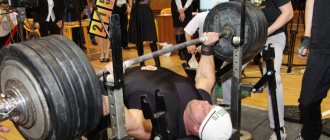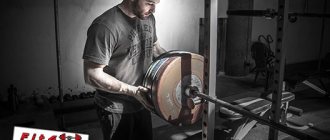When working out in the gym, people are faced with the problem of choosing a training program. There are a huge variety of training programs that are aimed at achieving various kinds of results: gaining weight, cutting, developing strength and endurance. The most popular are split workouts.
One example of this type of training is a five-day split. I propose to consider in this article who this type of training is suitable for, what its features are, how to break down muscle groups for five days, what exercises to use, how to eat.
Six day split rules
Intensity is a parameter that characterizes the maximum load, this parameter is usually used in powerlifting and is calculated from a personal maximum in a competitive lift for repetition. In this case, we are talking about achieving positive failure, when the athlete is no longer able to perform a single repetition without breaking the technique or with the help of a partner. During a six-day split, a straight pyramid is used, where the athlete increases the working weight from set to set, while only one “failure” repetition is allowed in the last approach. At the same time, “failure” is not at all necessary in all exercises, for example, in isolating exercises it is not at all necessary, but in basic exercises that stimulate strength indicators and ensure progression of loads, the last repetition in the last approach should be “failure”.
KPS is an abbreviation for the number of barbell lifts, or, more simply, training volume. This indicator, in combination with intensity, allows you to manipulate the magnitude of the load, that is, in essence, use microperiodization. In this case, it is recommended to use 3 to 5 working sets, starting with 12 repetitions per set and ending with 6. For intermediate sets, you can use any number of repetitions from 6 to 12, but we recommend gradually reducing them and increasing the working weight. The point is that you can perform, for example, 4 sets of 12 repetitions with less weight than performing the final approach of 6, and this is too big a “step” that limits your final result. The fact is that the larger the “step”, the worse the muscle innervation, since the central nervous system simply will not allow the creation of a nerve impulse of sufficient strength.
Diet is the main recovery factor that ensures muscle growth, although you should take into account that without 8-9 hours of sleep a day, it is almost impossible to recover even with the help of very competent nutrition. In general, the diet is quite simple, you need to eat as much as possible, the main thing is to eat at least the minimum
Usually everyone pays attention to the amount of protein, which should be 1-1.5 grams per kilogram of body weight
This parameter is often overestimated because it is beneficial for sports nutrition manufacturers, but in fact, what is truly important is the amount of carbohydrates, which should be 3-5 grams per kilogram of body weight. Fats should make up about 10-15% of the total diet, but there is no need to count them, because if you eat meat, fish, use sunflower or olive oil, then you get it in sufficient quantities
The only thing worth paying attention to is fish oil, which we recommend you take 2-3 times a year for a month
Fats should make up about 10-15% of the total diet, but they do not need to be counted, because if you eat meat, fish, use sunflower or olive oil, then you get it in sufficient quantities. The only thing worth paying attention to is fish oil, which we recommend that you take 2-3 times a year for a month.
Specialization is the practice of prioritizing training one muscle group more than others. A six-day split allows you to use specialization, but you should take into account that although all other muscle groups can theoretically be trained with the same intensity, nevertheless, since the adaptation reserve is limited, you should reduce the load. The priority muscle group is trained twice a week, dividing the workouts in such a way that on one training day you give more load to one part of the muscles of the priority muscle group, and on another training day to another part of it. The legs are divided into training the quadriceps and hamstrings, the latissimus dorsi into rows and rows from above, the chest into the lower and upper parts, the arms into biceps and triceps, the shoulders into the middle and rear deltoids. You can also specialize on the long back muscles, but it looks different, this is a strength program for working on deadlifts. One way or another, no matter how you group the muscle groups, you must consistently train the antagonist muscles, for example, after the chest, the latissimus dorsi muscles.
First week focus on legs and shoulders
Workout 1: Legs
| 5-10 min | video |
| 4x8-12 |
| 4x10-15 |
| 4×8-10 |
| 4x10-15 |
| 3x8-12 |
| 3x8-12 |
| 3x10-15 |
| 3×15-25 |
| 2-5 min | video |
General video
| Total load |
Only exercises count. Cardio load (if any) is not taken into account
| Front thigh | 39 (cruel) | Posterior thigh | 33 (cruel) |
| Buttocks | 32 (cruel) | Small of the back | 18 (average) |
| Inner thigh | 18 (average) | Calf muscle | 10 (average) |
| Press | 8 (weak) | Iliopsoas | 8 (weak) |
| Outer thigh | 8 (weak) | Forearms | 6 (weak) |
| Soleus muscle | 3 (weak) |
Workout 2: Shoulders
| 5-10 min | video |
| 3x12-18 |
| 4×6-10 |
| 4×10-15 |
| 4x8-12 |
| 4x10-15 |
| 3x10-15 |
| 3x10-15 |
| 2-5 min | video |
General video
| Total load |
Only exercises count. Cardio load (if any) is not taken into account
| Middle delta | 27 (high) | Anterior delta | 24 (high) |
| Upper back | 20 (high) | Triceps | 13 (average) |
| Press | 10 (average) | Rear delta | 7 (weak) |
| Biceps | 4 (weak) | Forearms | 4 (weak) |
Workout 3: Chest and Back
| 5-10 min | video |
| 3x10-15 |
| 5×6-10 |
| 3×10-15 |
| 3x6-12 |
| 3x8-12 |
| 3x10-15 |
| 2-5 min | video |
General video
| Total load |
Only exercises count. Cardio load (if any) is not taken into account
| Latissimus muscles | 27 (high) | Breast | 23 (high) |
| Upper back | 12 (average) | Small of the back | 10 (average) |
| Triceps | 9 (weak) | Forearms | 7 (weak) |
| Buttocks | 7 (weak) | Posterior thigh | 7 (weak) |
| Rear delta | 7 (weak) | Biceps | 7 (weak) |
| Anterior delta | 6 (weak) |
Workout 4: Biceps and Triceps
| 5-10 min | video |
| 3×12-18 |
| 3x6-12 |
| 3x10-15 |
| 4x6-12 |
| 3x10-15 |
| 3×10-15 |
| 3×10-15 |
| 2-5 min | video |
General video
| Total load |
Only exercises count. Cardio load (if any) is not taken into account
| Forearms | 32 (cruel) | Triceps | 20 (high) |
| Biceps | 15 (average) | Iliopsoas | 8 (weak) |
| Latissimus muscles | 8 (weak) | Press | 7 (weak) |
| Breast | 6 (weak) | Upper back | 3 (weak) |
| Anterior delta | 3 (weak) | Rear delta | 1 (weak) |
Workout five times a week in split mode
First of all, split (from the English word “divide”) is advisable when you have stopped getting results from “mixed training” according to the 3 strength, 2 cardio scheme. A five-day split is quite difficult for both the endocrine and nervous systems. Before you start, make sure that:
- you are not overtrained. The resting pulse in the morning does not exceed 70 beats per minute, the muscles do not ache for weeks on end, there is no significant swelling, there is a healthy appetite, but you do not slide into “zhor”;
- you can live without group cardio training. Combining strength training according to five-day split programs with lessons such as step, cycling or tai-bo is usually fraught with a lack of results and severe fatigue. Cardio with this regimen should be dosed, and it would be better for your muscles to be done in a separate session;
- you will not have problems with stress or overwork in the near future, since for recovery you will need deep and restful sleep 8-9 hours a day and regular nutrition;
- you do not use strict irrational diets, and eat according to a “fitness plan” - split meals, healthy low-glycemic foods, sufficient calorie content for significant exercise. Moreover, diets are not used for at least 3-4 months, and the diet, in general, satisfies and suits you.
There are several popular five-day split schemes:
"With an emphasis on relief." Cardio is performed strictly in the morning, before breakfast, and strength training is performed 6-12 hours after cardio, that is, in the afternoon or evening. Strength exercises are combined into supersets and performed in a pumping, high-repetition mode. Usually they “divide the body” like this - 1 day - chest, triceps, deltoids, 2 day - legs and buttocks, 3 day - back, biceps, 4 day - light leg training, plyometrics, or circuit training with light weights on the legs, 5 day – buttocks, deltoids and personally your “lagging muscle group”. Variations are also possible - the fourth day is replaced by training the chest and deltas, or the “lagging behind” days are divided into 2 days.
"For a beginner." Cardio is performed every training day, at the end of the session, in interval style. The machines, interval lengths and speeds vary each day. The power ones are divided according to a slightly different principle. The first day – “arms-abs”, the second – legs, the third – back/chest, the fourth – buttocks-deltoids, the fifth – lagging group, easy training.
In general, five training days, provided the training is done with full dedication, is a good way to get yourself into competition-worthy shape. But when using it, monitor your recovery, eat right and don’t forget about rest.
Proper nutrition is the key to health and longevity
Protein-vegetable diet for 20 days - an easy path to perfect shape
Buckwheat diet with kefir - losing weight with the help of the healthiest products
Buckwheat diet for weight loss - 3 effective methods
Dukan diet menu and tips by day
All the secrets of the low-carb diet
Healthy and easy weight loss in seven days with a water diet
Lose weight quickly with the grapefruit diet for weight loss
The best soup diet for weight loss
Benefits of a porridge diet: nutrition system of 6 porridges - minus 4 cm from the waist
FitLadies.ru - Magazine about weight loss and healthy eating. 2015–2017 All rights reserved
Copying materials is permitted only with an active link to the source
Our error on the site? Select it and press Ctrl + Enter
How many times to train
The optimal frequency of training is determined, first of all, by the main purpose of visiting the gym - from building muscle mass to increasing endurance or losing weight. This is what affects how many days the body needs to recover.
If long-term, but relatively light, cardio training for burning fat can be done 4-5 times a week, then strength training for the purpose of muscle growth definitely requires more time for recovery - the most effective frequency would be 3-4 visits to the gym per week.
Scientific studies show that the time it takes for muscles to recover is between 48 and 72 hours. In reality, the figure depends both on the total training experience and the age of the person (the older he is, the longer the recovery takes), and on which muscles were involved in the work.
Small and medium muscle groups (arms, shoulders, abs) require about 48-60 hours for regeneration, and for complete recovery of muscles and the central nervous system after basic exercises and working out large muscle groups (legs, chest, back) at least 72 hours are needed (1).
Muscle pain after exercise
If, after exercise, you feel specific “delayed” pain in your muscles (usually it begins 12 to 24 hours after exercise and ends 24 to 72 hours later), this means that the body is repairing muscles and removing toxins formed after exercise.
It is generally believed that this pain is directly related to muscle growth. This is not entirely true, and muscle growth can occur without pain - it all depends on the individual characteristics of a person’s metabolism. Note that active recovery and sports massage significantly reduce delayed pain.
Active recovery
Oddly enough, complete rest is not the optimal way to restore muscles - moderate physical activity on rest days from strength training increases blood flow and the rate of removal of toxins from the body, thus accelerating the processes of regeneration and growth of muscle tissue.
Light cardio exercise (rowing machine or elliptical) lasting 20-25 minutes on days free from strength training will not only speed up recovery, but will also have a positive effect on muscle definition. A visit to the sauna or water area of a fitness club may also be helpful.
5x5 training program for mass
An approximate class schedule for 5 days a week is as follows:
- Day 1 – Complex A
- Day 2 – Complex B
- Day 3 – Complex C
- Day 4 – Complex D
- Day 5 – Complex E
- Day 6 – Rest
- Day 7 – Rest
The advantage of starting classes on Monday is that while everyone else is doing chest presses and fiddling with dumbbells, you can calmly do deadlifts at the other end of the gym.
I would also recommend adding 20-30 minute cardio sessions after workouts at least twice a week to stimulate muscle growth and recovery.
When working out in the gym five times a week to build muscle mass, you should eat a lot of healthy and balanced foods. Chicken, broccoli, sweet potatoes, potatoes, bacon, ground beef, plenty of vegetables and whey protein will give your body everything it needs to grow, be strong and agility. The restoration of muscle fibers depends on an optimal diet and proper sleep patterns. Believe me, going to the gym and carrying heavy iron is not the most difficult task.
Complex A
| Exercise | Approaches | Max. number of repetitions |
| Deadlift | 5 | 5 |
| Shrugs with dumbbells | 3 | 8 |
| Rowing | 3 | 12 |
| Bent over dumbbell swings | 3 | 12 |
| Plank * | 3 | — |
Complex B
| Exercise | Approaches | Max. number of repetitions |
| Army press | 5 | 5 |
| Arnold press | 3 | 8 |
| Raising dumbbells forward | 3 | 12 |
| Dumbbell lateral raises | 3 | 12 |
Complex C
| Exercise | Approaches | Max. number of repetitions |
| Bent-over barbell row | 5 | 5 |
| Pull-ups | 3 | 8 |
| Barbell curl | 3 | 12 |
| Straight arm vertical block row | 3 | 12 |
Complex D
| Exercise | Approaches | Max. number of repetitions |
| Bench press | 5 | 5 |
| Incline dumbbell press with head up | 3 | 8 |
| Close grip bench press | 3 | 12 |
| One-arm triceps extension | 3 | 12 |
Complex E
| Exercise | Approaches | Max. number of repetitions |
| Squat | 5 | 5 |
| Raising on your toes *** | 3 | 8 |
| Leg bending on the simulator | 3 | 12 |
| Leg extension on the simulator | 3 | 12 |
| Plank * | 3 | — |
* - For planks, the number of repetitions is calculated differently. Perform the plank in three sets of one repetition, recording the result of each of them. Next time, try standing in one approach longer than the total time of the previous three. Reduce your rest time to 60 seconds, and try to tighten your abs and core muscles as much as possible and avoid arching your back.
*** - There are many variations of calf raises: sitting, standing, standing on a calf machine, standing in a Smith machine. Choose the one that suits you best.
If you have the courage to decide on such a tough training, leave a comment below. And after 8 weeks, come back and share your successes.
Share on social networks:
Nutrition for weight gain
When gaining weight, special attention is paid to nutrition. As we have already found out, in order to gain weight, you need to consume more calories than you expend.
But a lot of questions arise: what products are there? How much protein, fat, and carbohydrates should you consume? How many times should I eat? What time?
For weight gain, the proportion of proteins, fats, carbohydrates is as follows: 2/6/2 per kilogram of weight. Moreover, this proportion varies depending on your body type and your tendency to gain weight.
For an ectomorph, it is possible to increase the BJU until the weight gain meets your expectations.
You should take your food choices very seriously. Many people think that in order to gain weight, it is necessary to resort to eating fast food, fatty high-calorie foods, sweets, and starchy foods. These products should be limited as much as possible, because apart from fat mass and health problems, they will not give anything else. You need to rely on natural, natural products. The source of protein should be chicken, fish, beef, pork, eggs, and dairy products. It is these products that have a good amino acid composition, which is necessary for the growth of muscle tissue. The source of energy should be slow (complex carbohydrates) and healthy fats. As for carbohydrates, the main sources are porridge, buckwheat, oatmeal, rice, and other cereals.
Fats should be consumed from fish, as well as olive, flaxseed oil, foods rich in omega 3-6-9, which are necessary for the functioning of the cardiovascular system. You need to eat food 6-7 times a day, in small portions, so as not to burden the gastrointestinal tract, and all food is well absorbed. Please note that the most important meals are breakfast, pre-workout meal and post-workout meal. In the morning, the body is susceptible to nocturnal catabolism, so you need to prevent this process by replenishing carbohydrates and protein.
Before training, we need a supply of energy, so carbohydrates must be present in large quantities, and they must be slow. After training, it is necessary to replenish energy reserves and building material for muscles. In the first half of the day, the emphasis is on eating carbohydrate foods, in the second half of the day on protein foods.
By adhering to the recommendations described above, following a sports regimen that consists of productive training, proper and balanced nutrition, and good rest, you will definitely achieve your desired result. But it is worth understanding that we will not be able to get what we want in the shortest possible time, so we will have to make a lot of effort and spend a sufficient amount of time and then everything will work out.
A set of exercises for girls
Men come to the gym to gain weight, increase strength, or gain beautiful definition. Girls mainly use fitness clubs to lose weight, acquire and maintain attractive shapes, primarily hips, breasts and buttocks. The physiological characteristics of women also differ, so they will have their own program.
Day 1 – Legs
1. Warm up - jogging along the track for 5 minutes2. Deep squats with a 2×153 barbell. Leg press 2x154. Deadlift 1×155. Gluteal bridge 1×156. Leg extension in the simulator 2×157. Leg curls in the simulator 2×15
Day 2 – Cardio Monitor your heart rate, more details here.
1. Warm up – walking or jogging along the path for 30 minutes2. Jumping up from a half squat 2x153. Step platform climbs 2×154. Side plank 1×155. Pelvic lift on a fitball 1×156. Sitting shin extension in the simulator 1×157. Reverse lunges 1×15
Day 3 – Back
1. Warm up on the Orbitrek simulator for 5 minutes2. Gravitron pull-ups with a wide grip 2x153. Pull-ups in Gravitron with a reverse grip 2x154. Lower block thrust 2×155. Bent-over dumbbell row 2×156. Hyperextension 1×15
Day 4 – Chest
1. Warm up - jogging along the track for 5 minutes2. Dumbbell bench press 2×153. Dumbbell press at an angle of 2×154. Dumbbell fly 2×155. Reduction of arms in the Butterfly simulator 1×15
Day 5 – Hands
1. Warm up - jogging along the track for 5 minutes2. Dips in the Gravitron (elbows along the body) 2x153. Triceps block extension 2×154. Standing EZ-bar biceps curl 2×155. Seated dumbbell curls for biceps at an angle of 2×15
During the menstrual cycle, girls' general physical condition, mood, and well-being change, so the load needs to be distributed accordingly. The greatest performance is manifested in the first half of the cycle. During this period, you can actively adhere to this 5-day program. In the second half of the cycle, there is a decline in performance, so it is necessary to reduce the load - reduce the number of approaches and working weights. Directly during your period, you should focus on your well-being. At this time, the load should be reduced and exercises on the lower body should be eliminated. If necessary, you can reschedule the training.
Repost the pinned post on my VKontakte page and receive a book with training programs for naturals.
7.5% per annum on balance
Some useful tips
Deadlift. Your goal is 20 repetitions in 10 minutes. Treat each rep as if it were a single rep. Don't feel sorry for yourself, try your best.
Plank. Stay in the plank position for as long as possible until you fall.
Time relax. Decreasing rest time increases the intensity of the workout by increasing blood flow to the muscles. Rest no more than 45 seconds between sets. But if after this time you feel that you are not ready for the next set, do not push yourself, otherwise you risk injury.
Remember these tips and train 3 days a week with this program to gain muscle mass. If you're still seeing steady weight gain after 12 weeks, rest for a couple of weeks, target cardio, and cut back on calories a bit to lose some of the fat you gained during this cycle.
By following all the recommendations, you can increase strength and gain muscle mass. Train and the results will not be long in coming.
Rate this article:
How long should one workout last?
The ideal workout time for gaining weight is 45-60 minutes. This time is enough to complete the entire set of necessary exercises and load the muscles as much as possible. Many people think that the more time they train and do more exercises, the faster they will get into the desired shape. This statement is not true, especially when it comes to natural training, without the use of doping.
After an hour spent in the gym, the body begins to produce a large amount of the hormone, cortisol, aimed at destruction. That is why the situation turns out that instead of gaining weight, you will lose it.
Recommended Supplements
Without proper nutrition, any supplements and sports nutrition turn into a waste of money. I'll probably be the first to advise choosing a can of protein over a couple of kilos of good meat. But I hope that you already know this without me.
For those who do not have problems with the diet, below I provide a list of supplements that enhance the effects of this training method.
Pre-workout supplements
I prefer to train with pretrains while cutting, because with a low calorie diet, I no longer have the strength to maintain the normal intensity of the workout. But when gaining mass, you also need to give it your all, and if you are natural, then you also invest in 1 hour, the maximum is to finish the workout in 1 hour and 20 minutes.
Choose a blend that is moderate in stimulants.
Protein
In my opinion, the most pleasant-tasting protein is strawberry or babana. And there you can safely take it without additives. Oh yes, by company, take any from a store you trust. I personally prefer Optimum Nutrition. But you can take another brand of whey concentrate; this is the best option in terms of price-quality ratio.
The most optimal composition without any “surprises” in the form of an imaginary increased content of amino acids, which are easily digestible, or a large amount of fat with carbohydrates, which are already sufficient in the diet.
Calculation of the daily requirement should be done based on your protein requirement for the day and the amount you get from food. Personally, I drink one or two scoops in the morning and the same amount after training.
BCAAs
I use this supplement in the morning and after training, and can also take it on time if I haven't eaten well that day. It helps keep muscles from breaking down, especially in the morning and after exercise when cortisol levels rise. You can take from 5 to 30 grams. In essence, this is the same protein, but very quickly digested, which will enter the bloodstream faster than protein from chicken breast or even eggs. If money is tight, you can do without it.
Creatine
I have already written about him. This proven and effective sports nutrition will help you train harder and recover more effectively. Highly recommend. Beginners can start using it no earlier than after half a year of training, or better yet, after a year. This way you will accelerate your body’s own potential and then strengthen your capabilities. It can be taken 5 grams on an empty stomach with grape juice or honey. I personally take it in cycles, as it seems to me that it works better this way.
Workout five times a week 3 strength, 2 cardio
This regime is recognized by professionals as the most successful for losing weight when physical fitness has already been gained, healthy eating habits have been developed, and you have been doing fitness for 3-4 months without a break.
American specialist in fat-burning training K. Powell writes that three strength training sessions for the whole body with free weights plus 2 short cardio workouts allow you to lose weight and create relief without spending much time. Yes, if your goal is not to participate in body fitness competitions, but simply to have a toned, slender body, this will be the ideal regime.
Depending on your fitness experience and tolerance, use:
- circuit training on Monday, Wednesday and Friday, aimed at working all the muscles of the body, and including at least 5 basic exercises - squats, push-ups, compensated pull-ups, plank pose, military press. “Bonus” - short but “killer” HIIT cardio training (watch Zuzana Light’s channel or Tatianamania), sprints, 10 sets of 100 m running and walking until full recovery, sprints on an exercise bike, kettlebell training, mainly consisting of swings, lifts , jerks, jumping rope with alternating high and moderate tempos, etc.;
- three-day split, for example, on Monday you work the pectoral muscles, triceps and abs, on Wednesday - the back, biceps and buttocks (1-2 isolation exercises such as leg abduction on a lower block or leg abduction with a dumbbell), on Friday - legs and deltoids, and pump up your abs again, and on Tuesday and Thursday, go to group cardio classes or do any workouts available to you on a treadmill, exercise bike, stepper, or on the street.
The first option is recommended for girls who have previously attended group strength training classes and are just taking their first steps in the gym. It works well on ex-athletes of “cyclic” sports and dancers. In general, the result depends on genetics and diligence, but in this way, as a rule, it is not possible to pump up massive muscles, but simply “dries out” what is already there. The same option is recommended at the second (after general physical training) stage of losing weight from a lot of weight
The second option is for those who do not have too much body fat and want to build a body like the girls competing in the fitness bikini category. In case of significant excess weight, splits are not advisable. Still, for girls, the largest and most “energy-consuming” muscle group is the legs, so 1-2 complex exercises on them will only increase the fat-burning effect of the workout.
Recommended Supplements
If you are not following an appropriate diet, then taking supplements is a waste of money.
No matter how strange it may sound in the context of an article about a training program for gaining muscle mass, it is better to spend money on quality meat than on a package of protein.
If everything is in order with your nutrition, then the following supplements will definitely benefit you and your muscles.
Pre-workout supplements
Here you have your choice, but not everyone needs them. The best pre-workout option is any complex without an excessive amount of stimulants.
Protein
Whey protein is considered by many athletes to be the best supplement for muscle growth. Since it contains a full set of amino acids and is absorbed quite quickly. The cocktail can be taken immediately after training, as well as in the morning. And if there is not enough protein in your diet, you can drink one serving between meals. Whey protein is one of the best sports supplements that has proven its effectiveness.
Read more about what protein is and why the body needs it, especially during training for muscle growth.
BCAAs
This supplement consists of three amino acids leucine, isoleucine and valine, it protects muscle fibers from destruction by cortisol. It can be taken before, during or after training. It all depends on what kind of food you had before classes and how long ago it was.
Creatine
A truly high-quality supplement for gaining mass and strength. Improves endurance and speed of recovery of the body. Perfect for intense weight training.
Nutrition and diet tips
The most effective way to combine this training regimen is with nutrition to gain pure muscle mass. It will be easier to burn some fat afterward than to try to build muscle while lacking calories or, on the contrary, to gain on junk food such as sweets and fast food.
If you want to consistently gain weight and don't know how to increase your caloric intake, here is a list of foods that will allow you to do this without compromising your health:
- buckwheat
- rice
- durum pasta
- oatmeal
- eggs
- any chicken meat
- veal
- pork is not fatty
- any fish
- vegetables, the more the better
- oil (natural 82%)
- cream cheese
- sour cream
- whole milk
- heavy cream
- any cheese
- protein shakes
- peanut butter
- olive oil
- additional sauces and dressings
This will make your food tastier and enrich it with healthy fats. I prefer to fill the calorie deficit this way, instead of going to McDonalds and stocking up on several burgers at a time.
Your health will improve, you will become more alert and energetic, and your stomach will thank you.
Note: These products have significant energy value. Therefore, try not to overdo it, and clearly calculate the required number of calories.
Workout 6 days a week
07.08.2015 0 1,
Training program for all muscle groups 6 days a week.
Warning! If you are recovering for a long time, do not use this program often, otherwise you may end up overtraining...
This workout is designed for strong and resilient people, this training program qualitatively works all muscle groups, and after a few weeks you will already notice the results, the main thing is to rest a lot and eat well.
Weekly training schedule:
Monday. Exercises for hips and quadriceps.
- Squats with a barbell on the back. 6 sets of 10 times.
- Scissor squats. Perform eight 5 10 times.
- Squats performed with wide legs. 5 sets of 8 reps.
- Exercises on the simulator for bending and extending the legs. Perform 5 sets of 10 repetitions.
- Deadlift on straight legs. Perform 6 sets of 8 times.
- Snatch pull. Perform 5 sets of 8 times.
- Bent-overs with a barbell while standing. Perform 5 sets of 10 repetitions.
Tuesday. Exercises for the deltoid muscles.
- Bent-over rows using a wide grip (loads the rear deltoids). Perform 5 sets of 10 times.
- Dumbbell raises in an inclined position. Perform 3-4 sets of 10 times.
- Seated dumbbell or barbell press. Perform 3-4 approaches up to 10 times.
- Raising dumbbells to the sides. Perform 3-4 approaches 10 times.
- French press (dumbbell press from behind the head). Perform 5 sets of 10 times
- Seated dumbbell press. 3-4 sets of 10 times.
- Kettlebell row to the chin (loads the shoulder muscles). Perform 5 approaches up to 10 times.
- Pulling dumbbells forward. Perform 3-4 approaches 10 times.
Wednesday. Exercises for shins, calves, abs.
- Barbell or dumbbell calf raises. Perform 5 sets of 10-50 repetitions until burning occurs.
- Barbell or dumbbell calf raises with a partner. Perform 5 sets to failure.
- Calf raises on the machine. Perform 5 sets of 15 or more times.
- Calf raises on a leg press machine. Perform 5 sets of 15 or more times.
- Lifting on the abdominal machine with weights. Perform 5 sets of six or more times.
- Raising legs while hanging on the bar. Perform 5 sets to failure.
- Crunches on a horizontal block. Perform 3-4 approaches until failure.
Thursday. Back exercises.
- Pull-ups on a horizontal bar with weights. Perform 5 sets of 10 times.
- Pull on the upper block to the chest with an L-shaped adapter. Perform 5 sets of 10 repetitions.
- Pull on the upper block with a wide adapter to the back of the head. Perform 3-4 sets of 10 repetitions.
- Bent-over barbell row. Perform 3-4 sets of 10 repetitions.
- Bent-over dumbbell row. Perform 3-4 approaches 15 times, on each hand.
- Row on a vertical block to the waist. Perform 3-4 approaches 10 times.
- Pullover. Perform 4 sets to failure.
Friday. Exercises for the chest muscles.
- Bench press on an incline bench. Perform 5 sets of 15 repetitions.
- Incline dumbbell press. Perform 3-4 approaches 15 times, on each hand.
- Bent dumbbell curls at chest level. Perform 3 sets of 10-15 times..
- Wide grip bench press from a lying position. Perform 3-4 approaches 10-15 times.
- Dumbbell press from a lying position. Perform 3-4 approaches 10-15 times.
- Lying dumbbell flyes. Perform 3 sets of 10-15 times.
- Reduction of forearms on the machine. Perform 4 sets to failure.
Saturday. Exercises for arm muscles.
- Barbell curls for biceps. Perform 5 sets of 10-15 repetitions.
- Lifting dumbbells for biceps. Perform 3-4 approaches 10-15 times.
- Lifting dumbbells for biceps from a sitting position on an incline bench. Perform 3-4 approaches 10-15 times.
- French overhead press. Perform 3 sets of 10 times.
- French bench press. Perform 3 sets of 10 times.
- French dumbbell press from a seated position. Perform 3 sets of 10 times.
- Pull on the block to the back of the head. Perform 4 sets to failure.
After training, do a cool down, stretch the whole body, and don’t forget about proper nutrition.
Sleep and health
No matter how ideal your training programs are, without proper sleep and good health, you will not be able to build muscle.
Firstly, if you often get colds, you will take breaks from your classes. A week's break already rolls your results back.
Secondly, if you have weak connective tissue (a congenital diagnosis), you will be more likely than usual to pull the ligaments when reaching heavy weights
One careless movement or one bad warm-up is enough.
Thirdly, insufficient sleep greatly slows down anabolic processes in the body.
Therefore, you need to sleep well and toughen up. Building muscle requires stability and monotonous long-term work on your body, iron will and a healthy stomach.
In a competent program, it is important to indicate the correct working weight. It is selected experimentally
The effectiveness of each individual program depends on the correctness of its choice.










